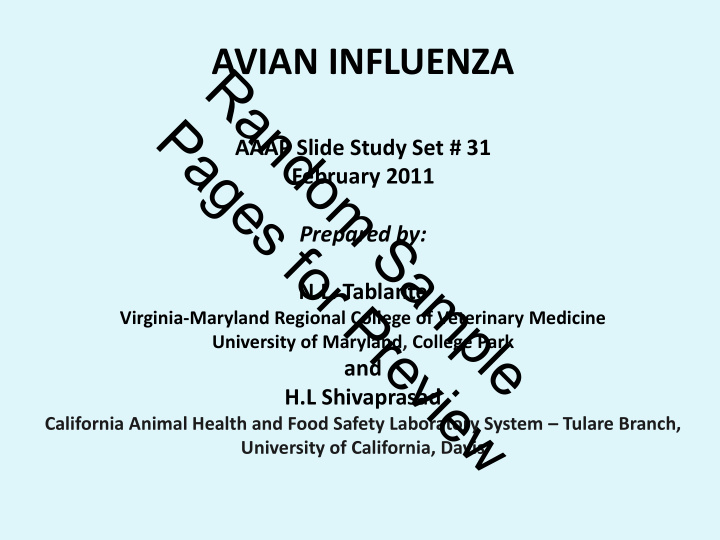



AVIAN INFLUENZA R a P n d a AAAP Slide Study Set # 31 o g February 2011 m e s Prepared by: S f o a r m N.L. Tablante P Virginia-Maryland Regional College of Veterinary Medicine p r l University of Maryland, College Park e e and v i H.L Shivaprasad e w California Animal Health and Food Safety Laboratory System – Tulare Branch, University of California, Davis
Etiology R a • Avian influenza (AI) is an infectious, viral disease of birds P n caused by several subtypes of the type A strain of the influenza d a o g virus. The virus occurs naturally among waterfowl and m e shorebirds which remain asymptomatic but may transmit the s virus to domestic poultry such as chickens, turkeys, and ducks. S f o a • Avian influenza presents itself in two distinct pathotypes, low r m pathogenic avian influenza (LPAI) and highly pathogenic avian P p influenza (HPAI). Most AI strains are LPAI and typically cause r l e e few clinical signs in infected birds. Some H5 and H7 LPAI strains v are capable of mutating under field conditions into HPAI i e viruses. HPAI is highly infectious and deadly amongst domestic w poultry. In recent epidemics of HPAI H5N1, the mutated virus infected and killed waterfowl, shorebirds, and human beings.
Classification R a P n • AI viruses are classified in two ways: d a o g • The first is by their antigenic makeup, which determines how m e s the host’s immune system responds. Influenza viruses have S two important surface antigens, hemagglutinin (H) and f o a neuraminidase (N). The name of the subtype of influenza r m reflects the combination of surface antigens; there are 16 H P p antigens and 9 N antigens. Cross-protection does not occur r l e between subtypes. e v • The other classification is by the severity of the disease they i e cause in domestic poultry (low pathogenic AI or LPAI and w highly pathogenic AI or HPAI as discussed previously).
Natural Distribution R a P n • All known subtypes of influenza A viruses circulate among d a o wild birds, especially migratory waterfowl (such as ducks g m e and geese) which are considered natural reservoirs for s influenza A viruses. S f • Domestic poultry like chickens and turkeys are not natural o a r m reservoirs for AI virus and usually develop clinical disease P when infected with AI virus. p r l e e v i e w
References R 1. Swayne, D.E. and D.A. Halvorson. 2008. Influenza. In Diseases of Poultry, 12 th ed. Y.M. Saif, A.M. Fadly, J.R. Glisson, L.R. McDougald, L.K. Nolan, and D.E. Swayne, eds. Blackwell Publishing, a Ames, IA. 153-184. P n d a 2. Swayne, D.E.., D.A. Senne, and D.L. Suarez. 2008 Avian Influenza. In A Laboratory Manual for the Isolation, Identification and Characterization of Avian Pathogens, 5 th ed. L. Dufour-Zavala, D.E. o g Swayne, J.R. Glisson, J.E. Pearson, W.M. Reed, M.W. Jackwood, and P.R. Woolcock, eds. American m e Association of Avian Pathologists, Athens, GA. 28-134. s 3. AVMA. 2006. Avian Influenza - Frequently Asked Questions. American Veterinary Medical S f Association . http://www.avma.org/public_health/influenza/avian_faq.asp o a r Images: m Slide 1: Influenza virus structure. (2006). Retrieved October 27, 2010 from: P http://micro.magnet.fsu.edu/cells/viruses/influenzavirus.html p r l e Slide 4: Live bird market (2006). Retrieved January 4, 2011 from e http://www.news.cornell.edu/stories/May06/bird_market.jpg v i Slide 6: Scheme of avian influenza pathogenesis and epidemiology [Diagram]. Retrieved August 26, 2009, from e http://www.influenzareport.com/ir/ai.htm w Slide 34: RT-PCR results for H5N1. (2006). Retrieved November 1, 2010 from http://www.eurosurveillance.org/images/dynamic/EE/V13N30/H5N1_Bulgaria_Figure1.jpg Slide 35: Real-time PCR results for H5N1. (2006). Retrieved November 1, 2010 from http://www.eurosurveillance.org/images/dynamic/EE/V13N30/H5N1_Bulgaria_Figure2.jpg
Acknowledgement R The authors would like to thank Dr. David Swayne for his valuable a P n comments and gross pathology slides 21 and 22, and Dr. D. Read d a for providing additional gross pathology slides. o g m e s S f o a r m P p r l e e v i e w
Recommend
More recommend